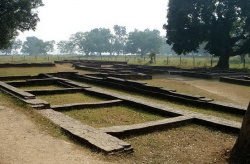Difference between revisions of "Lumbinī"
m (Text replace - "nature" to "nature") |
|||
| (One intermediate revision by one other user not shown) | |||
| Line 1: | Line 1: | ||
[[File:Lumbinī.jpg|thumb|250px|]] | [[File:Lumbinī.jpg|thumb|250px|]] | ||
| − | Lumbinī was a nature reserve between the towns of Kapilavatthu and Devadaha and was where Siddhattha Gotama, who later became the Buddha, was born. Mahā Māyā,his mother, was on her way to Devadaha to have her baby when the birth pangs began and the child was born in Lumbinī instead. In later centuries Lumbinī became an important centre of pilgrimage and remained so until at least the beginning of the 14th century. After the disappearance of Buddhism in India, Lumbinī was gradually overgrown by jungle and was only rediscovered in 1896. Today the place is located just within the border of Nepal. The most important monument at Lumbinī is a huge stone pillar with an inscription by King Aśoka saying that he visited the place in the year 249 BCE. The inscription reads: ‘Twenty years after his coronation King Aśoka visited this place and worshipped because here the Buddha, the sage of the Sākyans, was born. He had a stone figure and a pillar set up because the Lord was born here and the village was exempted from tax and required to pay only one eighth of the produce.’ | + | [[Lumbinī]] was a nature reserve between the towns of [[Kapilavatthu]] and [[Devadaha]] and was where [[Siddhattha]] [[Gotama]], who later became the [[Buddha]], was born. Mahā Māyā,his mother, was on her way to [[Devadaha]] to have her baby when the [[birth]] pangs began and the child was born in [[Lumbinī]] instead. In later centuries [[Lumbinī]] became an important centre of [[pilgrimage]] and remained so until at least the beginning of the 14th century. After the [[disappearance]] of [[Buddhism]] in [[India]], [[Lumbinī]] was gradually overgrown by jungle and was only rediscovered in 1896. Today the place is located just within the border of [[Nepal]]. The most important monument at [[Lumbinī]] is a huge stone pillar with an inscription by [[King]] [[Aśoka]] saying that he visited the place in the year 249 BCE. The inscription reads: ‘Twenty years after his [[coronation]] [[King]] [[Aśoka]] visited this place and worshipped because here the [[Buddha]], the sage of the [[Sākyans]], was born. He had a stone figure and a pillar set up because the [[Lord]] was born here and the village was exempted from tax and required to pay only one eighth of the produce.’ |
| − | The Places where Siddhartha Trod; Lumbini and Kapliavastu, Max Deeg, 2003. | + | The Places where [[Siddhartha]] Trod; [[Lumbini]] and Kapliavastu, Max Deeg, 2003. |
{{R}} | {{R}} | ||
[http://www.buddhisma2z.com/content.php?id=235 www.buddhisma2z.com] | [http://www.buddhisma2z.com/content.php?id=235 www.buddhisma2z.com] | ||
Latest revision as of 12:45, 5 September 2013
Lumbinī was a nature reserve between the towns of Kapilavatthu and Devadaha and was where Siddhattha Gotama, who later became the Buddha, was born. Mahā Māyā,his mother, was on her way to Devadaha to have her baby when the birth pangs began and the child was born in Lumbinī instead. In later centuries Lumbinī became an important centre of pilgrimage and remained so until at least the beginning of the 14th century. After the disappearance of Buddhism in India, Lumbinī was gradually overgrown by jungle and was only rediscovered in 1896. Today the place is located just within the border of Nepal. The most important monument at Lumbinī is a huge stone pillar with an inscription by King Aśoka saying that he visited the place in the year 249 BCE. The inscription reads: ‘Twenty years after his coronation King Aśoka visited this place and worshipped because here the Buddha, the sage of the Sākyans, was born. He had a stone figure and a pillar set up because the Lord was born here and the village was exempted from tax and required to pay only one eighth of the produce.’
The Places where Siddhartha Trod; Lumbini and Kapliavastu, Max Deeg, 2003.
